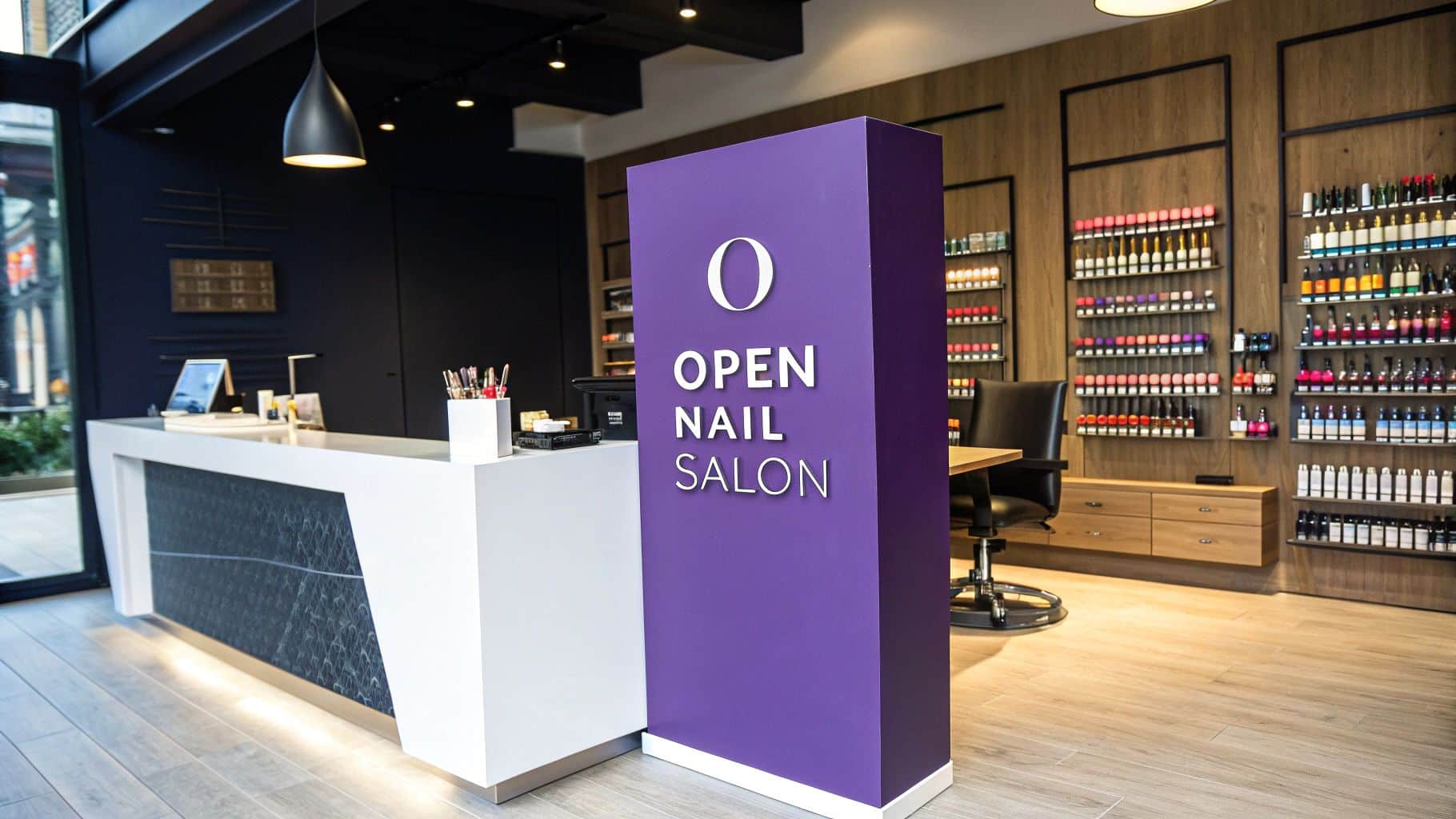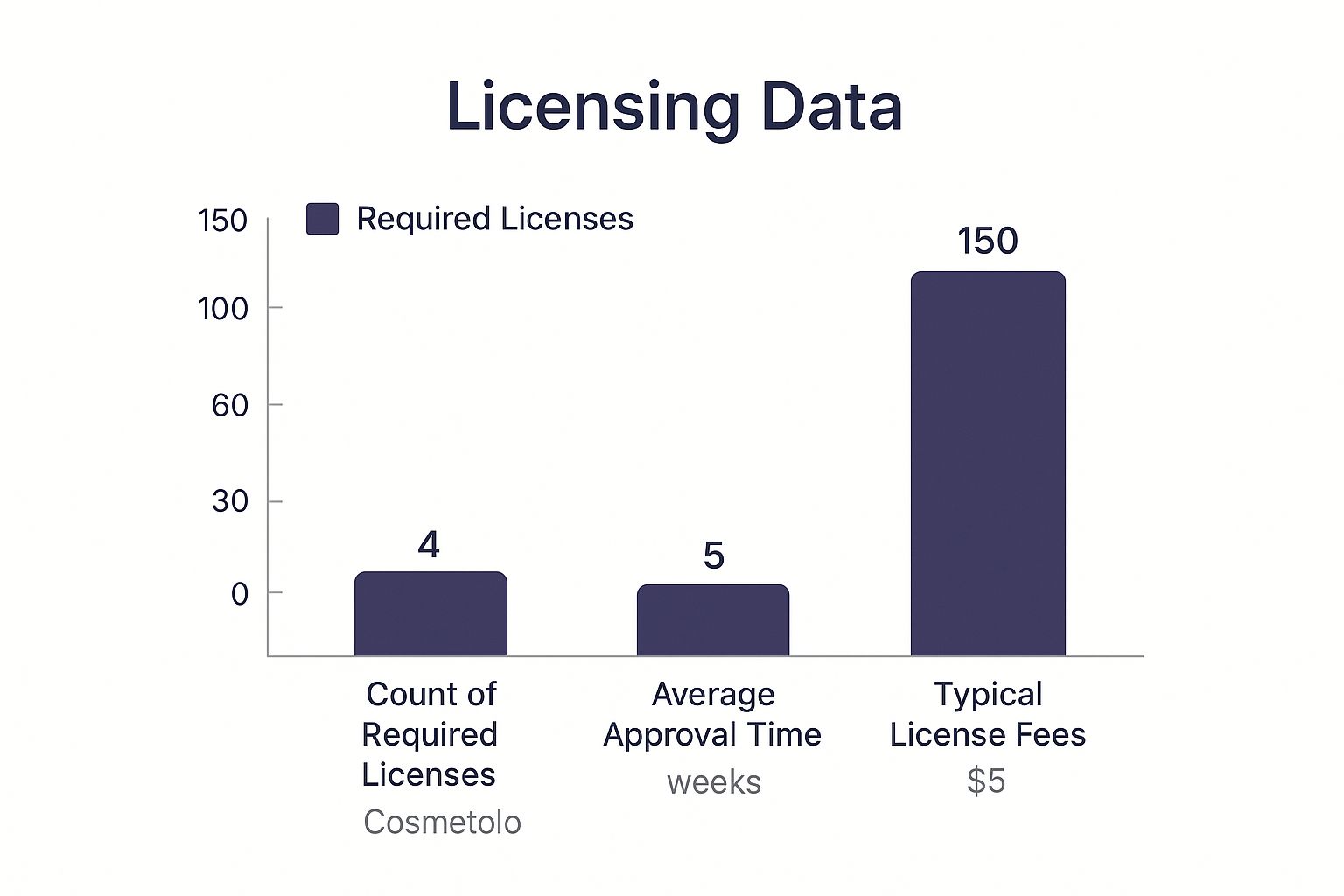How to Open a Nail Salon Your Complete Guide

Opening a nail salon is more than just a passion for polish; it starts with turning that creative spark into a rock-solid plan. This guide provides actionable steps to figure out what makes your salon special, research your local market, and map out your launch to secure funding and build a successful business.
Crafting Your Nail Salon Business Plan
Think of your business plan as the blueprint for your future salon. It's not just a formal document for investors—it's your personal roadmap to stay on track and think through every detail before you spend a dime. This is your first actionable step.
Your first move is to define your salon's concept and unique brand identity. This decision shapes everything: your decor, services, pricing, and even your social media voice.
- Actionable Step: Choose Your Salon Vibe.
- Luxury Spa Retreat: High-end, serene escape with premium products and a focus on relaxation. Target clients willing to pay more for a full experience.
- Trendy Nail Art Bar: Vibrant, social studio focused on the latest trends and intricate designs. Perfect for a younger, fashion-forward crowd.
- Cozy Neighborhood Spot: A friendly, go-to salon known for consistent quality and a warm, community feel that builds loyalty.
Pinpoint Your Ideal Clients and Competition
Once you've chosen your concept, it's time for market research. Don't just Google other salons; get out there and experience them firsthand.
- Actionable Step: Conduct Competitor Analysis.
- Identify 3-5 local competitors in the neighborhood you're considering.
- Book an appointment at each one to secretly evaluate their service quality, pricing, atmosphere, and overall client experience.
- Take detailed notes. Are the stations clean? Is the team welcoming? How long was the wait?
- Identify the gaps. Use this information to find weaknesses in the market that your salon can fill. This firsthand intelligence is what will help you build a business that stands out.
A classic rookie mistake is trying to be everything to everyone. The most successful salons know exactly who their ideal client is and tailor every single part of their business to make that person feel right at home.
Building Realistic Financial Projections
This is where your vision meets the bottom line. Your financial plan must be honest and detailed, covering every potential cost and revenue stream. Nailing these numbers is crucial for securing funding and ensuring your salon's long-term health. For structured guidance, a comprehensive business starter pack can provide useful templates.
- Actionable Step: Outline Your Finances.
- List Startup Costs: Create a spreadsheet of all one-time expenses: lease deposits, renovation costs, initial equipment purchases (pedicure chairs, UV lamps), and license/permit fees.
- List Operating Expenses: Detail your recurring monthly costs: rent, utilities, staff payroll, marketing, and restocking supplies like polishes and files.
- Create a Revenue Forecast: Project your income conservatively for the first 1-3 years. Base this on your service prices, number of technicians, and a realistic estimate of weekly appointments.
It also helps to show you understand the bigger picture. The global nail salon market was valued at a whopping $11 billion in 2022 and is expected to hit $20.30 billion by 2030. That kind of growth shows that people are hungry for nail services, especially cool things like intricate nail art and long-lasting gel extensions. This is a massive opportunity.
To make this whole process way less intimidating, we've put together a guide and framework you can customize. Check out our https://gohappybeauty.com/nail-salon-business-plan-template/ to get everything organized.
Handling Legal and Financial Setup
With your business plan complete, it's time to make it official. While navigating legal and financial tasks can feel tedious, getting this foundation right from the start is non-negotiable. It protects you, your business, and your future clients from major headaches.
Your first big decision is your business structure. This choice impacts your taxes and personal liability. Most new salon owners choose between a sole proprietorship and a Limited Liability Company (LLC).
- Actionable Step: Choose a Business Structure.
- Sole Proprietorship: The simplest option. You and the business are legally the same entity. It's easy to set up, but it offers no personal liability protection. If the business is sued, your personal assets (car, house) could be at risk.
- Limited Liability Company (LLC): Creates a legal separation between you and your business. If the salon faces debt or legal trouble, your personal assets are generally protected. It's a popular choice for its balance of protection and simplicity.
Securing Essential Licenses and Permits
With your business structure sorted, the next hurdle is obtaining all the required licenses and permits. This is a legal requirement, and operating without them can lead to hefty fines or even closure.
- Actionable Step: Create a Licensing Checklist.
The specific licenses you'll need vary by state and city, but your list should include researching these common requirements:- State Cosmetology or Nail Technician License: Every technician you hire must be licensed. Research your state's specific rules. A great resource is this list of esthetician and cosmetology license requirements by state.
- General Business License: A standard license required by most cities or counties to operate any business.
- Seller's Permit: Required if you plan to sell retail products like lotions or polishes.
- Certificate of Occupancy (CO): A certificate from your local government confirming your salon space is safe and up to code. You cannot open without it.
- Health Department Permit: Required to ensure your sanitation and hygiene practices meet public health standards.
This infographic gives you a quick look at the typical time and cost you can expect.

As you can see, the cosmetology licenses often take longer to get approved because they have to go through board reviews. Business permits are usually faster, but the cost can really vary from one city to the next.
Setting Up Your Salon's Finances
A solid financial setup is the backbone of a successful salon. From day one, it is critical to keep your business and personal finances completely separate to avoid accounting nightmares and potential tax issues.
- Actionable Step: Organize Your Finances.
- Open a dedicated business bank account. All salon revenue goes in, and all business expenses come out. This simple step will save you immense stress during tax season.
- Consider hiring an accountant, ideally one with experience in the beauty industry. They can advise on cash flow management, salon-specific tax deductions, and proper payroll setup.
- Secure your funding. While some owners self-fund, many need help with startup costs. Explore these popular options:
- SBA Loans: Government-backed small business loans that often have favorable terms.
- Equipment Financing: A loan specifically for purchasing big-ticket items like pedicure chairs.
- Business Line of Credit: A flexible option that lets you borrow money as needed up to a set limit, great for unexpected costs.
Never underestimate the power of a clean financial record. It's your most powerful tool when seeking funding, tracking profitability, and making smart decisions about your salon's growth.
Choosing a Location and Designing Your Salon
Your salon’s location and interior design are two of your most powerful marketing tools. A great location makes you easy to find, while a well-designed interior makes clients want to stay, return, and recommend you to their friends.

This process is about creating an environment that works as hard as you do. Let's break down the strategic decisions that go into finding the perfect spot and creating an unforgettable atmosphere.
Scouting for the Perfect Spot
When figuring out how to open a nail salon, the real estate mantra "location, location, location" is critical. The right spot can reduce your marketing budget by providing built-in visibility and a natural flow of potential clients.
- Actionable Step: Use This Location Checklist.
Spend time in your target neighborhoods at different times of day. As you scout properties, measure them against these criteria:- Daily Foot Traffic: Is the area busy with people near popular cafes, shops, or grocery stores? More eyes on your business means more potential walk-ins.
- Street Visibility: Can your salon be easily seen from the street? A large storefront window acts as a free billboard for your beautiful interior.
- Convenient Parking: A lack of easy parking is a major deterrent. Look for locations with a dedicated lot or ample street parking.
- Local Demographics: Does the neighborhood's population match your ideal client? A trendy nail art bar might thrive near a university, while a luxury spa could succeed in an affluent residential area.
The goal isn't just to find an empty storefront. It's to find a space that slots perfectly into the daily lives of your target customers, making a visit to your salon feel like a convenient and natural part of their routine.
Designing a Functional and Inviting Floor Plan
Once you've signed the lease, the real fun begins: designing your salon's interior. A brilliant design must balance beautiful aesthetics with operational efficiency. Your floor plan should create a relaxing experience for clients while allowing your technicians to work smoothly.
- Actionable Step: Map Out Your Salon Zones.
A well-defined layout prevents chaos and maintains a serene atmosphere, even when you're busy.- Reception & Waiting Area: This is your salon's first impression. It should be clean, welcoming, and have comfortable seating. Design attractive, well-lit retail displays here.
- Manicure Stations: This is the heart of your operation. Ensure enough space between stations for comfort. Good ventilation and task lighting are non-negotiable.
- Pedicure Chairs: This area should feel more private and spa-like. Plan the location carefully, as plumbing is a major consideration.
- Sanitation & Storage: A dedicated, visible sanitation station builds client trust. Ample organized storage is crucial to keep the salon from looking cluttered.
- Break Room: A small, private space for your team to rest away from the main floor is essential for morale.
Choose materials that are both stylish and practical. Opt for durable, easy-to-clean flooring like luxury vinyl tile. Invest in ergonomic chairs for your technicians to prevent strain and keep them comfortable. Every design choice should reinforce the brand identity you worked hard to create.
Sourcing Your Salon's Equipment and Professional Products
The tools and products you choose are the foundation of your client's experience and your reputation. High-quality equipment delivers better results, while professional-grade products create beautiful, long-lasting nails that build loyalty. This is your guide to buying smart, balancing cost with the quality your clients expect.
- Actionable Step: Create Your Shopping List.
Separate your list into two categories: one-time equipment purchases and recurring supply orders. Your initial equipment investment will be a large part of your startup costs, so prioritize durable, ergonomic pieces that meet state health codes.
The Big-Ticket Essentials
These are the non-negotiable items that form the backbone of your salon. Investing in quality now will save you money on repairs and replacements later. Clients notice wobbly tables and uncomfortable chairs, so don't cut corners here.
- Manicure Stations: Look for tables with built-in ventilation to manage dust and fumes, as well as good storage to keep the workspace tidy.
- Pedicure Chairs: Comfort is key. Choose chairs that are easy for clients to access, with reliable plumbing and non-porous materials for easy sanitation.
- UV/LED Curing Lamps: You'll need at least one per manicure station. Opt for professional, dual-source lamps that can cure both UV and LED gel polishes for maximum flexibility.
- Sterilization Tools: Client safety is paramount. An autoclave is the gold standard for sterilizing metal tools with high-pressure steam. Also invest in a hospital-grade disinfectant and a UV sterilizer cabinet.
Think of your equipment as a silent business partner. A high-quality pedicure chair that provides a comfortable, spa-like experience can be a key differentiator that turns a first-time visitor into a loyal, repeat client.
Stocking Your Shelves and Building Supplier Relationships
Once your equipment is secured, it's time to stock up on professional products. This is where you define the quality of your services. Resist the urge to buy consumer-grade polishes; professional formulas offer better application, durability, and color range.
- Actionable Step: Build Your Inventory.
- Find a Reputable Supplier: Forge a strong relationship with a beauty supplier to get access to bulk pricing, new collections, and industry advice.
- Create a Starter Product List:
- Polishes and Gels: Start with a core collection of classic colors (reds, nudes) and add trendy seasonal shades. Include base coats, top coats (glossy and matte), and a range of gel polishes.
- Nail Care Essentials: Cuticle oil, removers (acetone and non-acetone), scrubs, and lotions.
- Tools and Implements: High-quality metal nippers, pushers, and clippers.
- Disposables: Nail files, buffers, orangewood sticks, cotton balls, foil wraps, and disposable pedicure tub liners are non-negotiable for hygiene.
Use a simple spreadsheet or inventory management software to track product usage. This data will help you avoid overstocking unpopular colors and ensure you never run out of your most in-demand supplies.
Building Your A-Team and Nailing Your Service Menu
Your salon's success ultimately depends on two things: the talented people on your team and the profitable menu you offer. Your team creates the atmosphere and client experience, while your menu drives revenue. Getting both right is fundamental.
Your technicians are your brand ambassadors. They need to be skilled, licensed, and share your commitment to outstanding customer service. Their personality and ability to connect with clients are just as important as their technical abilities.
Assembling Your Dream Team
Don't rush the hiring process. You are building a cohesive team that works well together and is dedicated to your salon's high standards.
- Actionable Step: Follow a Structured Hiring Process.
- Post Clear Job Descriptions on industry-specific boards, social media, and at local beauty schools.
- Conduct a Skills Test. Have every candidate perform a service (e.g., a gel manicure) on a model. This is the only way to truly assess their technical skill, cleanliness, timing, and attention to detail.
- Verify All Credentials. Personally confirm that their state cosmetology or nail technician license is active and in good standing. This protects your business and ensures client safety.
- Assess the Vibe. Look for positive, team-oriented individuals. One toxic employee can ruin the atmosphere for everyone.
Designing a Menu That Makes Money
Your service menu is one of your most powerful sales tools. A well-designed menu guides clients toward more profitable services and encourages them to try new things. The goal is to find the perfect balance between competitive pricing and strong profitability.
- Actionable Step: Engineer a Profitable Menu.
- Research Competitor Pricing. Know what other local salons are charging to position yourself appropriately. You don't have to be the cheapest, but you need to be informed.
- Calculate Your Cost Per Service. Factor in product cost, your technician's time, and overhead for every single service to ensure each appointment is profitable.
- Create Service Tiers. Offer a great basic manicure, then create deluxe and luxury versions that include high-margin add-ons like a longer massage, paraffin wax, or intricate nail art. Our guide on crafting the perfect salon service menu offers more detailed strategies.
The most profitable salons aren't just selling manicures; they're selling an experience. Your menu needs to reflect that. Think bundled packages and tempting add-ons that make the visit feel special and, not-so-secretly, boost your average ticket.
Keep your finger on the pulse of the industry. The global nail salon market is exploding, projected to grow from $11.16 billion in 2021 to $14.38 billion by 2025. This growth is fueled by consumer interest in personal grooming and unique nail art. To stay competitive, find your niche—whether it's advanced techniques, a focus on sanitation, or offering the latest trends. You can discover more insights about the nail salon market on cognitivemarketresearch.com to stay ahead of the curve.
Marketing Your New Nail Salon
You've designed a stunning space and hired an amazing team. Now, you need to make sure clients know you exist. Marketing is the bridge that connects your salon to a full appointment book. This is your game plan for creating buzz and building a brand that becomes the talk of the town.

Your marketing efforts should begin long before your grand opening. The key is a smart mix of digital strategy and on-the-ground networking.
Build Your Digital Foundation
In the beauty industry, your online presence is your storefront. For many potential clients, it's their first impression of your salon. A professional, visually appealing online footprint is essential.
- Actionable Step: Set Up Your Online Presence.
- Launch a simple, clean, mobile-friendly website. It must include:
- Services and clear pricing.
- An easy-to-use online booking system.
- A photo gallery of your work and salon interior.
- Contact info, address, and a map.
- Create a business Instagram account. Use it as your living portfolio, filled with high-quality photos and videos of your work. Engage with your followers to let your salon's personality shine.
- Launch a simple, clean, mobile-friendly website. It must include:
Master Your Local Visibility
As a local business, your primary customers are in your neighborhood. Local search engine optimization (SEO) is your superpower here. When someone searches "nail salon near me," you need to appear at the top of the results.
- Actionable Step: Optimize for Local Search.
- Claim and fully optimize your Google Business Profile. Fill out every section, upload numerous photos, and encourage every happy client to leave a review. Positive reviews are powerful trust signals for both Google and new customers.
- Learn the basics of local SEO. Understanding how to improve your local SEO can be a game-changer for your visibility.
- Run targeted local ads on Facebook and Instagram. You can target users within a specific radius of your salon, making it an effective and budget-friendly way to reach new locals.
Your marketing isn't just about getting new people in the door; it's about turning them into regulars who can't imagine going anywhere else. The easiest customer to book is the one you already have, so make retention a core part of your strategy from day one.
Create Buzz with Offline Tactics
Never underestimate the power of real-world connections. Getting out in your community builds genuine relationships and brand loyalty that digital ads can't always buy.
- Actionable Step: Engage with Your Community.
- Plan a grand opening event. Invite local influencers, other business owners, and neighbors for an evening of mini-manis, drinks, and special launch promotions to create instant buzz.
- Partner with complementary local businesses like boutiques or coffee shops. Cross-promote by offering exclusive discounts to each other's clients.
- Launch a referral program immediately. Offer a discount to both the client who refers a friend and the new friend they bring in. This turns your happiest customers into your most powerful advocates.
Answering Your Nagging Questions About Opening a Nail Salon
Even with a solid business plan, a few questions can cause uncertainty as opening day approaches. Getting clear answers is key to moving forward with confidence.
Let’s tackle some of the most common questions from aspiring salon owners.
How Much Does It Really Cost to Start a Nail Salon?
The honest answer is that it varies widely. A small, leased booth setup could start around $20,000, while a larger, custom-built salon in a prime location could easily exceed $100,000.
The biggest factors that influence your final budget are:
- Location and Rent: A security deposit and first month's rent in a high-traffic urban area will cost significantly more than a suburban space.
- Renovations: A simple paint job is far cheaper than extensive construction and plumbing work for pedicure stations.
- Equipment Quality: High-end, ergonomic chairs and stations are a larger investment than basic, entry-level models.
How Much Profit Can a Nail Salon Actually Make?
Profitability also varies, but a well-managed salon can be a very successful business. On average, a small to mid-sized salon can generate a monthly profit between $2,000 and $8,000 after all expenses are paid (rent, payroll, supplies, etc.).
Your profit margin is directly tied to your service pricing, client volume, and operational efficiency. The most profitable salons excel at upselling with high-margin add-ons and have a strong retail program.
What Licenses Do I Absolutely Need to Have?
This is non-negotiable. While specific rules differ by state and city, you can almost certainly count on needing the following:
- Business License: A standard permit from your city or county to operate a business.
- Cosmetology Establishment License: A license for your physical salon location from the state cosmetology board.
- Individual Technician Licenses: Every single person performing services on clients must hold a valid state nail technician or cosmetology license. This includes you, the owner, if you plan to do nails.
- Certificate of Occupancy: Proof that your building is safe and up to code for business operations.
Here’s a classic rookie mistake: assuming that as the owner, you don’t need a professional license if you only plan to manage. Wrong. If you ever intend to fill in for a sick tech or perform any service on a client, you must be personally licensed. Always, always check your state board's specific rules on this.
How Can I Make My Salon Stand Out from the Competition?
The nail industry is crowded. To succeed, you must be memorable. You don't have to be the cheapest or the fanciest, but you must give people a reason to choose you.
It all comes down to creating an incredible client experience. You can stand out by:
- Specializing in a niche: Become the go-to spot for intricate, hand-painted nail art or build a brand around all-natural, non-toxic services.
- Providing exceptional customer service: Remember clients' names, offer complimentary drinks, and create a relaxing, welcoming atmosphere.
- Building a strong social media brand: Use consistent, high-quality photos of your work to build a loyal following and showcase your unique style. Your unique vibe is your single greatest marketing tool—use it.
Ready to build a stunning website that brings your unique salon vision to life? At gohappybeauty, we create beautiful, SEO-optimized websites designed specifically for beauty professionals to help you attract the right clients from day one. Get started with gohappybeauty today.
Grow your beauty business
Our focus is, and always will be, helping you improve your online presence and generate more business from your website. That is what we do, for you.

